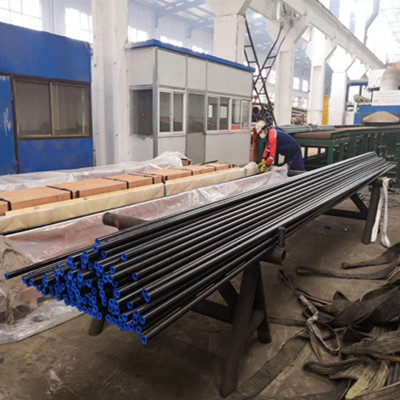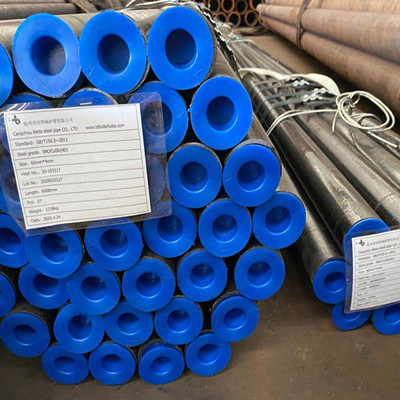Grade 20 steel
Grade 20 steel
Grade 20 steel is a kind of Chinese GB standard alloy steel. The 20 of Grade 20 steel is 0.2% carbon ,which belongs to high-quality low-carbon carbon steel.
Grade 20 steel has good comprehensive mechanical properties after quenching and low temperature tempering: good low temperature impact toughness and tempering brittleness are not obvious. The steel has low strength, good toughness, plasticity and weldability. Grade 20 steel usually does not require heat treatment after welding, but parts greater than 15mm need to be preheated to 100-150 ° C before welding, and tempering heat treatment may not be possible after welding.

Application of Grade 20 steel:
Grade 20 steel is suitable for manufacturing small and medium-sized carburized carbonitriding parts such as hand brake shoes, lever shafts, transmission speed forks, and passive gears in automobiles, tractors, and general machinery manufacturing. And tractor camshaft, suspension equalizer shaft, inner and outer bushes of equalizer, etc .;
Used in the manufacture of various mechanical parts that are not stressed and require high toughness in the hot-rolled or normalized state; in heavy and medium-sized machinery manufacturing, such as forged or pressed tie rods, shackles, levers, sleeves , Fixtures, etc. In the steam turbine and boiler manufacturing industry, it is mostly used for pipes, flanges, headers and various fasteners working in non-corrosive media with a pressure of ≤6N / square and a temperature of ≤450 ℃; it is used to make crosses on railways and locomotives Head, piston and other castings.
Grade 20 steel mold parts technology:
Blanking → forging mold blank → annealing → mechanical rough machining → cold extrusion molding → recrystallization annealing → mechanical finishing → carburization → quenching and tempering → grinding and polishing → assembly.
Chemical composition
Mechanical properties
1. Phase transition temperature (approximate value) Ac1 = 735 ℃, Ac3 = 855 ℃, Ar3 = 835 ℃, Ar1 = 680 ℃
2. Normalizing specification Temperature: 920 ~ 950 ℃, air cooling out of the oven. Hardness 131 ~ 156HBS.
3. Specification for softening treatment of cold-pressed blanks. The temperature is 700 ~ 720 ℃, the holding time is 8 ~ 15h, and the cooling rate is 50 ~ 100 ℃ / h, and the temperature is reduced to ≤550 ~ 600 ℃ with the furnace.
The hardness before treatment is ≤143HBS, and the hardness after softening is ≤131HBS.
4. Quenching specification Temperature: 910 ℃ ± 10 ℃, 10% NaCl brine cooling.
5. Measured yield strength fy = 245Mpa, elastic modulus E = 206Gpa, Poisson's ratio ν = 0.3.
6. Shear strength is 275 ~ 392MPa, tensile strength is 253 ~ 500MPa, yield strength is 275MPa, and elongation is 25%.
7. The annealing temperature is only 600-650 degrees, and the holding time is 1-2h.
Allowable stress
1.Allowable stress of Grade 20 steel at 225 ℃: (16-36mm) between 111-124MPa; (6-16mm) between 117-131MPa
2.Allowable stress of Grade 20 steel at 100 ° C: At 150 ° C, the allowable stress of No. 20 steel pipe is 130 MPa, and the allowable stress of Grade 20 steel forging is 108 MPa
Comparison of Grade 20 steel and Grade 15 steel
Both steels are low carbon steels. From the data point of view, Grade 20 steel has a high carbon content, and the metallurgical structure of both is pearlite + ferrite. The performance reflected in the performance is that the tensile strength and impact toughness of Grade 20 steel are slightly higher, basically there is no big difference between the two steels. Both types of steel cannot be quenched, and the heat treatment process is relatively simple. Usually, the blank is directly cut or forged for normalizing. It is used for unimportant structural parts, connections or stamping parts, or as carburizing steel.

Equivalent Grade
German DIN standard material number 1.0402, German DIN standard steel number CK22 / C22, British BS standard steel number IC22, French AFNOR standard steel number CC20, French NF standard steel number C22, Italian UNI standard steel number C20 / C21, Belgium NBN standard steel C25-1, Swedish SS standard steel number 1450, Spanish UNE standard steel number F.112, American AISI / SAE standard steel number 1020, and Japanese JIS standard steel number S20C / S22C.
Grade 20 steel is a kind of Chinese GB standard alloy steel. The 20 of Grade 20 steel is 0.2% carbon ,which belongs to high-quality low-carbon carbon steel.
Grade 20 steel has good comprehensive mechanical properties after quenching and low temperature tempering: good low temperature impact toughness and tempering brittleness are not obvious. The steel has low strength, good toughness, plasticity and weldability. Grade 20 steel usually does not require heat treatment after welding, but parts greater than 15mm need to be preheated to 100-150 ° C before welding, and tempering heat treatment may not be possible after welding.

Application of Grade 20 steel:
Grade 20 steel is suitable for manufacturing small and medium-sized carburized carbonitriding parts such as hand brake shoes, lever shafts, transmission speed forks, and passive gears in automobiles, tractors, and general machinery manufacturing. And tractor camshaft, suspension equalizer shaft, inner and outer bushes of equalizer, etc .;
Used in the manufacture of various mechanical parts that are not stressed and require high toughness in the hot-rolled or normalized state; in heavy and medium-sized machinery manufacturing, such as forged or pressed tie rods, shackles, levers, sleeves , Fixtures, etc. In the steam turbine and boiler manufacturing industry, it is mostly used for pipes, flanges, headers and various fasteners working in non-corrosive media with a pressure of ≤6N / square and a temperature of ≤450 ℃; it is used to make crosses on railways and locomotives Head, piston and other castings.
Grade 20 steel mold parts technology:
Blanking → forging mold blank → annealing → mechanical rough machining → cold extrusion molding → recrystallization annealing → mechanical finishing → carburization → quenching and tempering → grinding and polishing → assembly.
Chemical composition
| Grade | C | Si | Mn | Cr | P ≤ | S ≤ | Cu ≤ | Ni ≤ | Mo ≤ |
| 20 | 0.18 – 0.24 | 0.17 – 0.37 | 0.50- 0.80 | 0.70 – 1.00 | 0.030 | 0.030 | 0.030 | 0.030 | 0.030 |
Mechanical properties
1. Phase transition temperature (approximate value) Ac1 = 735 ℃, Ac3 = 855 ℃, Ar3 = 835 ℃, Ar1 = 680 ℃
2. Normalizing specification Temperature: 920 ~ 950 ℃, air cooling out of the oven. Hardness 131 ~ 156HBS.
3. Specification for softening treatment of cold-pressed blanks. The temperature is 700 ~ 720 ℃, the holding time is 8 ~ 15h, and the cooling rate is 50 ~ 100 ℃ / h, and the temperature is reduced to ≤550 ~ 600 ℃ with the furnace.
The hardness before treatment is ≤143HBS, and the hardness after softening is ≤131HBS.
4. Quenching specification Temperature: 910 ℃ ± 10 ℃, 10% NaCl brine cooling.
5. Measured yield strength fy = 245Mpa, elastic modulus E = 206Gpa, Poisson's ratio ν = 0.3.
6. Shear strength is 275 ~ 392MPa, tensile strength is 253 ~ 500MPa, yield strength is 275MPa, and elongation is 25%.
7. The annealing temperature is only 600-650 degrees, and the holding time is 1-2h.
Allowable stress
1.Allowable stress of Grade 20 steel at 225 ℃: (16-36mm) between 111-124MPa; (6-16mm) between 117-131MPa
2.Allowable stress of Grade 20 steel at 100 ° C: At 150 ° C, the allowable stress of No. 20 steel pipe is 130 MPa, and the allowable stress of Grade 20 steel forging is 108 MPa
Comparison of Grade 20 steel and Grade 15 steel
Both steels are low carbon steels. From the data point of view, Grade 20 steel has a high carbon content, and the metallurgical structure of both is pearlite + ferrite. The performance reflected in the performance is that the tensile strength and impact toughness of Grade 20 steel are slightly higher, basically there is no big difference between the two steels. Both types of steel cannot be quenched, and the heat treatment process is relatively simple. Usually, the blank is directly cut or forged for normalizing. It is used for unimportant structural parts, connections or stamping parts, or as carburizing steel.

Equivalent Grade
German DIN standard material number 1.0402, German DIN standard steel number CK22 / C22, British BS standard steel number IC22, French AFNOR standard steel number CC20, French NF standard steel number C22, Italian UNI standard steel number C20 / C21, Belgium NBN standard steel C25-1, Swedish SS standard steel number 1450, Spanish UNE standard steel number F.112, American AISI / SAE standard steel number 1020, and Japanese JIS standard steel number S20C / S22C.
| USA | Germany | Japan | France | England | European | Italy | Belgium | Spain | China | Sweden | Bulgaria | Hungary | Poland | Romania | Czechia | Australia | Switzerland | South Korea | ||||||||||||||||||||||||||||||||||||||||||||||||||
| - | DIN,WNr | JIS | AFNOR | BS | EN | UNI | NBN | UNE | GB | SS | BDS | MSZ | PN | STAS | CSN | AS | SNV | KS | ||||||||||||||||||||||||||||||||||||||||||||||||||
|
|
|
|
|
|
|
|
|
|
|
|
|
|
|
|
|
|
|




